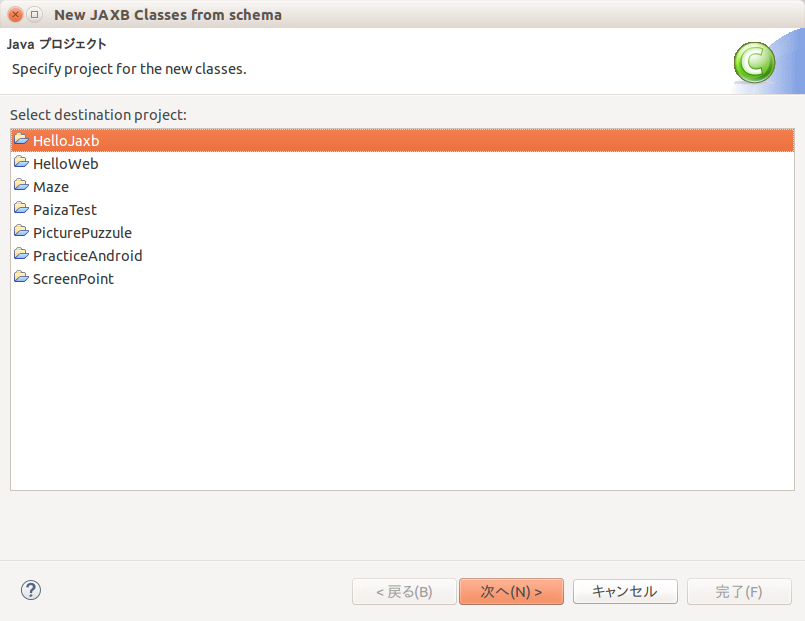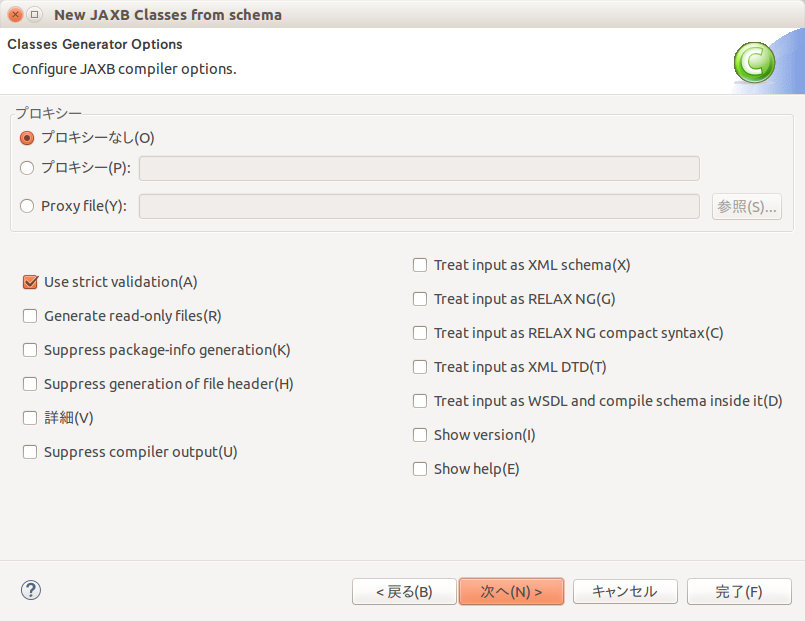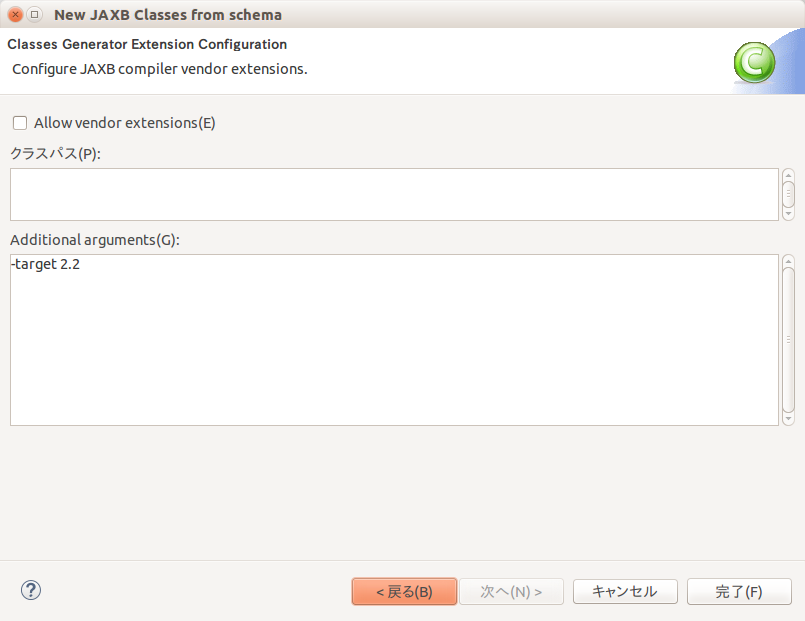JavaEE 7をやってみよう。 JAX-RS その6
その5の続き。
<?xml version="1.0" encoding="UTF-8" standalone="yes"?> <xs:schema version="1.0" xmlns:xs="http://www.w3.org/2001/XMLSchema"> <xs:element name="result" type="catalog"/> <xs:complexType name="catalog"> <xs:sequence> <xs:element name="shipList" type="warShip" minOccurs="0" maxOccurs="unbounded"/> </xs:sequence> </xs:complexType> <xs:complexType name="warShip"> <xs:sequence> <xs:element name="type" type="xs:string" minOccurs="0"/> <xs:element name="name" type="xs:string" minOccurs="0"/> </xs:sequence> </xs:complexType> </xs:schema>
これを書き換えるのだけど、
XMLスキーマの細かい書き方はよくわからない。
仕様については検索すれば詳しいページはいくらでもある、のだろうが、
ここはインスタントでいく。
まず、内容を見る限りComplexTypeとあるところが型宣言のようだ。
CatalogとWarShipの2つ。これはJavaクラスと一致する。
ここにあるelement属性をよく見ると、
"result", "shipList", "type", "name"の4種と、
出力されるタグの種類が一致していることがわかる。
ということは。。。。
element属性にwarShipListとwarShipを追加してやればよいのではないか?
と思いたち、そんな具合に直してみることにする。
<?xml version="1.0" encoding="UTF-8" standalone="yes"?> <xs:schema version="1.0" xmlns:xs="http://www.w3.org/2001/XMLSchema"> <xs:element name="result" type="catalog"/> <xs:complexType name="catalog"> <xs:sequence> <xs:element name="warShipList" type="warShipList" minOccurs="1" maxOccurs="1" nillable="false" /> </xs:sequence> </xs:complexType> <xs:complexType name="warShipList"> <xs:sequence> <xs:element name="warShip" type="warShip" minOccurs="0" maxOccurs="unbounded"/> </xs:sequence> </xs:complexType> <xs:complexType name="warShip"> <xs:sequence> <xs:element name="type" type="xs:string" minOccurs="0"/> <xs:element name="name" type="xs:string" minOccurs="0"/> </xs:sequence> </xs:complexType> </xs:schema>
変更点は、warShipListの型宣言の追加、
Catalogのelement名をwarShipListに変更し、型をwarShipList型としたこと。
ついでにNULL不許可とか最小出現数、最大出現数なんかも増やした。
これを元にJavaクラスを作ってみる。
スキーマファイルは新規のウィザードから作ったが、
xsdファイルからJavaクラスの生成は、コンテキストメニューからでも行ける。
xsdファイルを選択し、コンテキストメニューから「生成」→「JAXB Classes」を選ぶ。
- 1. 保存先のプロジェクトを選択。
- 今回はJAXBプロジェクトを選んだ。

- 2. 出力パッケージの選択
- xsd生成元のJavaクラスと同じ場所にした。

- 3. オプション選択。
- 詳しくは調査が必要なので、今回はデフォルトのままにした。


- 4. 生成
- 完了ボタンを押すと生成が始まる。
今回、既存のクラスがすでにあったため警告が出るが、上書きで問題ないため「はい」を押す。
Javaリソースを見てみるとクラスが書き換わっているのがわかる。
- Catalogクラス
// // This file was generated by the JavaTM Architecture for XML Binding(JAXB) Reference Implementation, v2.2.4-2 // See <a href="http://java.sun.com/xml/jaxb">http://java.sun.com/xml/jaxb</a> // Any modifications to this file will be lost upon recompilation of the source schema. // Generated on: 2015.08.21 at 04:28:09 PM JST // package jaxrs.bean; import javax.xml.bind.annotation.XmlAccessType; import javax.xml.bind.annotation.XmlAccessorType; import javax.xml.bind.annotation.XmlElement; import javax.xml.bind.annotation.XmlType; /** * <p>Java class for catalog complex type. * * <p>The following schema fragment specifies the expected content contained within this class. * * <pre> * <complexType name="catalog"> * <complexContent> * <restriction base="{http://www.w3.org/2001/XMLSchema}anyType"> * <sequence> * <element name="warShipList" type="{}warShipList"/> * </sequence> * </restriction> * </complexContent> * </complexType> * </pre> * * */ @XmlAccessorType(XmlAccessType.FIELD) @XmlType(name = "catalog", propOrder = { "warShipList" }) public class Catalog { @XmlElement(required = true) protected WarShipList warShipList; /** * Gets the value of the warShipList property. * * @return * possible object is * {@link WarShipList } * */ public WarShipList getWarShipList() { return warShipList; } /** * Sets the value of the warShipList property. * * @param value * allowed object is * {@link WarShipList } * */ public void setWarShipList(WarShipList value) { this.warShipList = value; } }
- WarShipListクラス
// // This file was generated by the JavaTM Architecture for XML Binding(JAXB) Reference Implementation, v2.2.4-2 // See <a href="http://java.sun.com/xml/jaxb">http://java.sun.com/xml/jaxb</a> // Any modifications to this file will be lost upon recompilation of the source schema. // Generated on: 2015.08.21 at 04:28:09 PM JST // package jaxrs.bean; import java.util.ArrayList; import java.util.List; import javax.xml.bind.annotation.XmlAccessType; import javax.xml.bind.annotation.XmlAccessorType; import javax.xml.bind.annotation.XmlType; /** * <p>Java class for warShipList complex type. * * <p>The following schema fragment specifies the expected content contained within this class. * * <pre> * <complexType name="warShipList"> * <complexContent> * <restriction base="{http://www.w3.org/2001/XMLSchema}anyType"> * <sequence> * <element name="warShip" type="{}warShip" maxOccurs="unbounded" minOccurs="0"/> * </sequence> * </restriction> * </complexContent> * </complexType> * </pre> * * */ @XmlAccessorType(XmlAccessType.FIELD) @XmlType(name = "warShipList", propOrder = { "warShip" }) public class WarShipList { protected List<WarShip> warShip; /** * Gets the value of the warShip property. * * <p> * This accessor method returns a reference to the live list, * not a snapshot. Therefore any modification you make to the * returned list will be present inside the JAXB object. * This is why there is not a <CODE>set</CODE> method for the warShip property. * * <p> * For example, to add a new item, do as follows: * <pre> * getWarShip().add(newItem); * </pre> * * * <p> * Objects of the following type(s) are allowed in the list * {@link WarShip } * * */ public List<WarShip> getWarShip() { if (warShip == null) { warShip = new ArrayList<WarShip>(); } return this.warShip; } } || :WarShipクラス: >|java| // // This file was generated by the JavaTM Architecture for XML Binding(JAXB) Reference Implementation, v2.2.4-2 // See <a href="http://java.sun.com/xml/jaxb">http://java.sun.com/xml/jaxb</a> // Any modifications to this file will be lost upon recompilation of the source schema. // Generated on: 2015.08.21 at 04:28:09 PM JST // package jaxrs.bean; import javax.xml.bind.annotation.XmlAccessType; import javax.xml.bind.annotation.XmlAccessorType; import javax.xml.bind.annotation.XmlType; /** * <p>Java class for warShip complex type. * * <p>The following schema fragment specifies the expected content contained within this class. * * <pre> * <complexType name="warShip"> * <complexContent> * <restriction base="{http://www.w3.org/2001/XMLSchema}anyType"> * <sequence> * <element name="type" type="{http://www.w3.org/2001/XMLSchema}string" minOccurs="0"/> * <element name="name" type="{http://www.w3.org/2001/XMLSchema}string" minOccurs="0"/> * </sequence> * </restriction> * </complexContent> * </complexType> * </pre> * * */ @XmlAccessorType(XmlAccessType.FIELD) @XmlType(name = "warShip", propOrder = { "type", "name" }) public class WarShip { protected String type; protected String name; /** * Gets the value of the type property. * * @return * possible object is * {@link String } * */ public String getType() { return type; } /** * Sets the value of the type property. * * @param value * allowed object is * {@link String } * */ public void setType(String value) { this.type = value; } /** * Gets the value of the name property. * * @return * possible object is * {@link String } * */ public String getName() { return name; } /** * Sets the value of the name property. * * @param value * allowed object is * {@link String } * */ public void setName(String value) { this.name = value; } }
- ObjectFactoryクラス
// // This file was generated by the JavaTM Architecture for XML Binding(JAXB) Reference Implementation, v2.2.4-2 // See <a href="http://java.sun.com/xml/jaxb">http://java.sun.com/xml/jaxb</a> // Any modifications to this file will be lost upon recompilation of the source schema. // Generated on: 2015.08.21 at 04:28:09 PM JST // package jaxrs.bean; import javax.xml.bind.JAXBElement; import javax.xml.bind.annotation.XmlElementDecl; import javax.xml.bind.annotation.XmlRegistry; import javax.xml.namespace.QName; /** * This object contains factory methods for each * Java content interface and Java element interface * generated in the jaxrs.bean package. * <p>An ObjectFactory allows you to programatically * construct new instances of the Java representation * for XML content. The Java representation of XML * content can consist of schema derived interfaces * and classes representing the binding of schema * type definitions, element declarations and model * groups. Factory methods for each of these are * provided in this class. * */ @XmlRegistry public class ObjectFactory { private final static QName _Result_QNAME = new QName("", "result"); /** * Create a new ObjectFactory that can be used to create new instances of schema derived classes for package: jaxrs.bean * */ public ObjectFactory() { } /** * Create an instance of {@link Catalog } * */ public Catalog createCatalog() { return new Catalog(); } /** * Create an instance of {@link WarShipList } * */ public WarShipList createWarShipList() { return new WarShipList(); } /** * Create an instance of {@link WarShip } * */ public WarShip createWarShip() { return new WarShip(); } /** * Create an instance of {@link JAXBElement }{@code <}{@link Catalog }{@code >}} * */ @XmlElementDecl(namespace = "", name = "result") public JAXBElement<Catalog> createResult(Catalog value) { return new JAXBElement<Catalog>(_Result_QNAME, Catalog.class, null, value); } }
自動生成されたクラスを見るとXML系のアノテーションの付け方が異なることがわかる。
@XmlAccessorTypeアノテーションだとか、@XmlElementの付ける位置だとか、色々。
これらを元にアノテーションについて調査をすれば、
もっと詳しい仕様が理解できると思う。
が、それはまた別の機会にするとして、
自動生成したクラスをREST用のプロジェクトにコピーして、
出力結果を確認してみることにする。
といったところで、次回に続く。